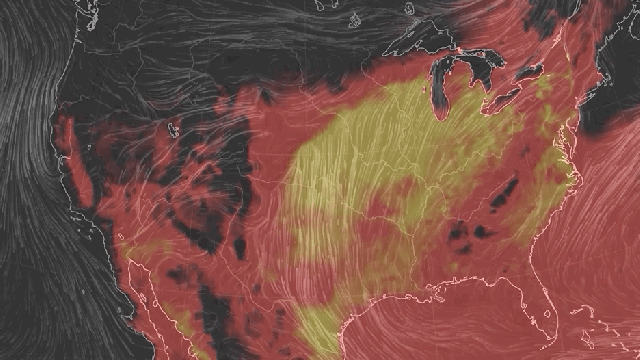The only thing worse than the hottest time of summer is a heat wave on top of the hottest time of summer. And lo and behold, that’s exactly what the eastern U.S. is to deal with.
A powerful heat dome coupled with disgustingly moist air will envelop the country from the Rockies to the Eastern Seaboard starting their Wednesday and peaking on Friday and Saturday. During that time, an astounding 290 million people could experience temperatures above (and in some cases well above) 32 degrees Celsius. Records could fall and cities are already preparing for dangerous heat by opening cooling centres.
If this sounds like climate change, well, yeah this is basically what it looks like.
The cause of the dire heat is a bump in the jet stream. The fast-moving river of air running from west to east can act like a dam, separating cooler air to the north from hotter, humid air to the south.
A blossoming area of high pressure over the eastern two thirds of the country will push the jet stream further north, allowing heat to build and humid air to come up from the tropics. The high pressure also means sunny skies, which will create a feedback loop of more heat and more intense high pressure. Temperatures are expected to rise 10-20 degrees above normal.
Excessive heat warnings blanket the Upper Midwest and parts of the Mid-Atlantic with the U.S. National Weather Service warning “[d]angerously high temperatures and humidity could quickly cause heat stress or heat stroke if precautions are not taken.” Temperatures will climb into the upper 90s and low 100s from Texas to Iowa to New York.
But add in the humidity and you have a recipe for sultry conditions normally seen in places like the Texas Gulf Coast as far north Iowa. The combined heat plus humidity means some cities could experience a heat index above 43 degrees Celsius during the day. The National Weather Service’s Philadelphia office emphasised the risks noting the high heat index will create a “DANGEROUS SITUATION.”
Cities will be particularly hard hit due to the urban heat island effect. All the paved surfaces absorb heat throughout the day and radiate it well into the night. That means overnight lows will not be so low, posing a huge public health risk.
In Washington, D.C., overnight low temperatures are forecast to stay above 26 degrees Celsius and there’s an outside chance the District could see its warmest night ever recorded according to Capital Weather Gang (that would be 28 degrees Celsius, a record set in 1983 and tied in 2011).
In response to the blanket of heat descending on the U.S., Philadelphia, along with other cities, are opening cooling centres for those lacking access to air conditioning.
Cities are also facing down the prospect of blackouts like the one that hit New York last week as their grids strain to handle the load of increased air conditioner use.
This round of heat perfectly encapsulates what climate change is doing to our weather. Rising background temperatures have given heat waves a springboard that has made them increasingly common and more intense. Last month’s record-smashing heat wave in Europe, for example, was at least five times more likely due to climate change according to a rapid response analysis.
Overnight lows are also rising faster than daytime highs in another symptom of climate change. That add more strain on people’s health, particularly kids and the elderly, by reducing the amount of time they have to cool off.Â
And then there’s the combo of heat and humidity itself, which a newly released Union of Concerned Scientists (UCS) report shows will become more common and dangerous in the coming century.
Many of the locations sweltering this week are likely to see even hot, humid weather in the future including some days that in UCS’ estimation will be “off the charts” from what was once normal.
So while there’s no particular analysis (yet) of this heat wave’s relationship with climate change, it certainly fits a pattern and serves as a reminder heat will only get worse. That’s why we’re all probably going to be living in Siberia by the end of the century.
